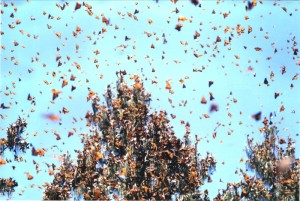Monarch butterflies, like orange autumn leaves filling the skies, have been winging it to Mexico for the last month or so. Peak migration for the mountains of Western North Carolina is from mid to late September through early to mid October.
But don’t be surprised if you still see one or two – there is still time for them to make it to Mexico. Tagging data has shown that monarchs can cover up to 500 miles in three days under favorable conditions. Migration is generally more leisurely than this, however. A monarch tagged on October 7 at Cape May, New Jersey by Mark Garland was recaptured on October 24 at St. Marks National Wildlife Refuge in Florida – a distance of 807 miles. A monarch tagged in Central Park on August 27, 2005 was recaptured at El Rosario Monarch Sanctuary, 2,150 miles away on February 14, 2006. And these bugs aren’t afraid of heights, they have been recorded migrating at altitudes above 11,000 feet.
The monarch migration story is a biological mystery. Most adult butterflies live about a month or so. Their primary function is to propagate the species. It has often been said that a butterfly is just the breeding stage of a caterpillar. But the last emerging monarch of the summer doesn’t fit this mold. It is not sexually mature when it leaves the chrysalis. Instead, it turns south and heads for Mexico. It will not sexually mature for six to eight months, when it leaves Mexico in the spring and heads back to North America where it will emerge from reproductive diapause and begin the common cycle of breeding, egg-laying and then the adult will go to that happy butterfly garden in the sky, while the egg hatches, the caterpillar grows, then pupates and the chrysalis opens to reveal another generation of monarch butterfly. The other part of the migration mystery is maybe, even more, intriguing. The animal that eventually turns south, towards Mexico, is as many as four (or more) generations removed from the animal that left Mexico in the spring. How this creatures finds its way back to the same area in the mountains of central Mexico every fall is a wonder.
Colonies of overwintering Monarchs in Mexico last winter were at their lowest-ever numbers. Researchers estimated the population at around 33 million, which was about half of 2012’s 60 million.
Biologists are studying this precipitous population drop to qualify and quantify its causes. Likely culprits appear to be habitat loss (primarily the loss of milkweed, its host plant) plus herbicides and/or pesticides. This year’s fall migration shows promise of a slight rebound in population. Seventy-four fall roosts of migrating monarchs in the central flyway were recorded this year. That is up from 28 in 2012 and 24 in 2013. There were also more roosts with more than 1,000 butterflies recorded – 11 this year, compared to 4 in 2012 and 3 in 2013. More population data will be available after scientists do a population census on the monarch’s wintering grounds in December.
There are a number of websites where you can learn about monarchs and many offer Citizen-science opportunities plus explain simple things you can do in your yard and/or on your property to aid this wonderful and wondrous pollinator. Two websites are: Monarch Joint Venture (http://monarchjointventure.org/) and Monarch Butterfly Journey North (http://www.learner.org/jnorth/monarch/.)

